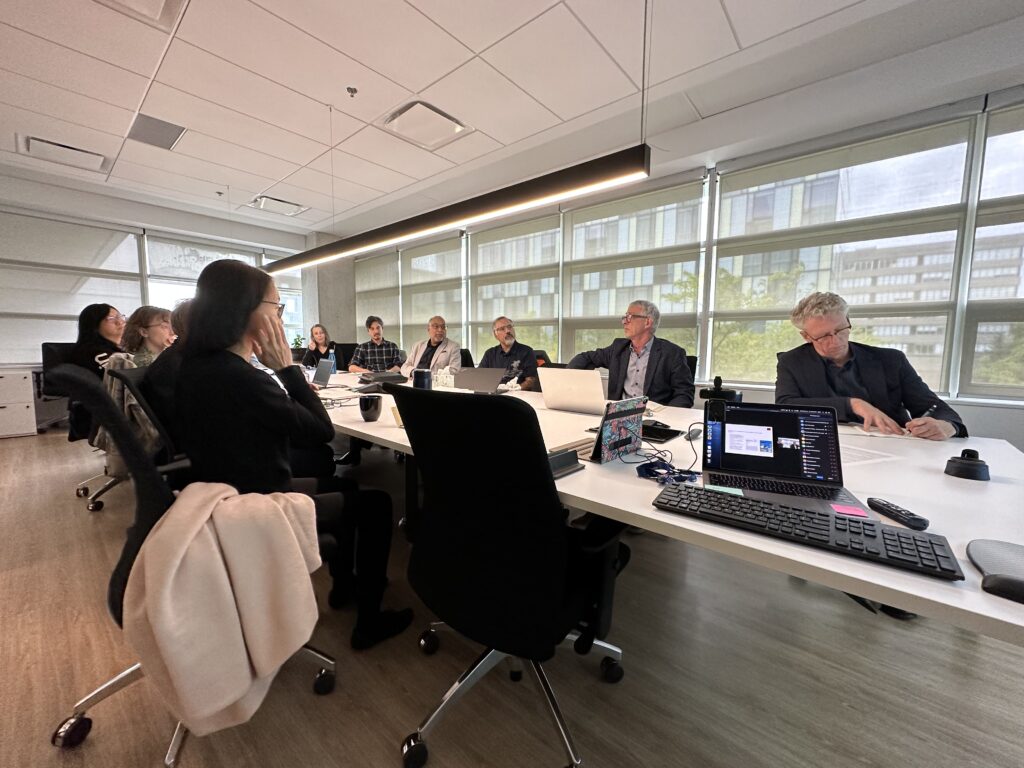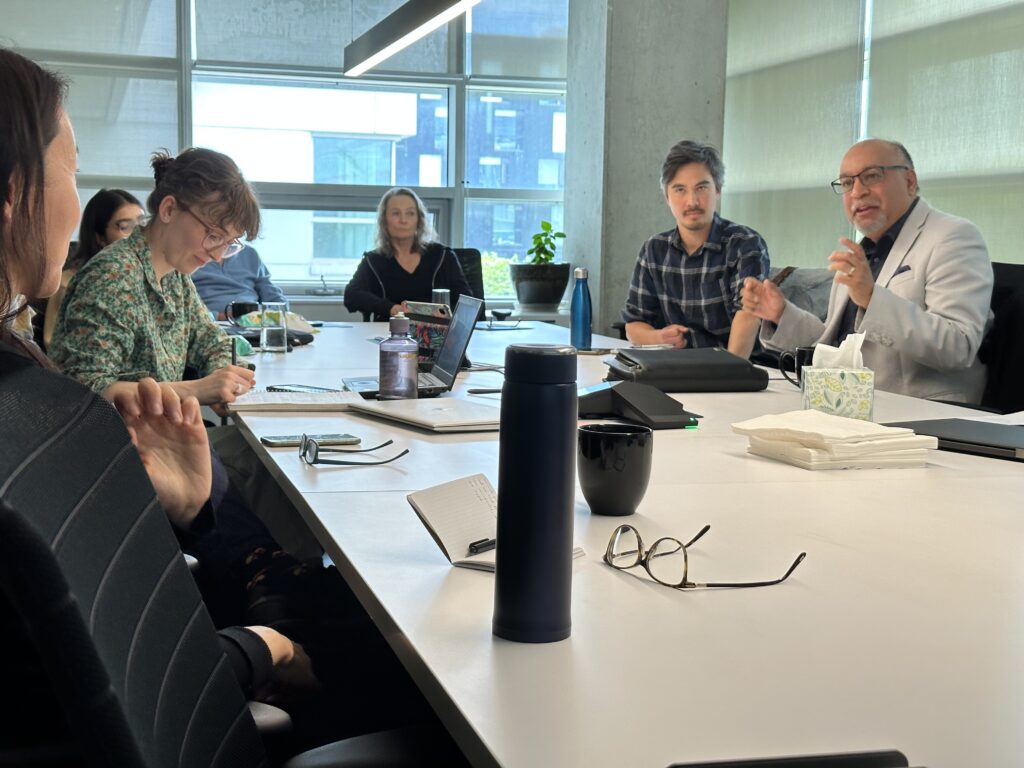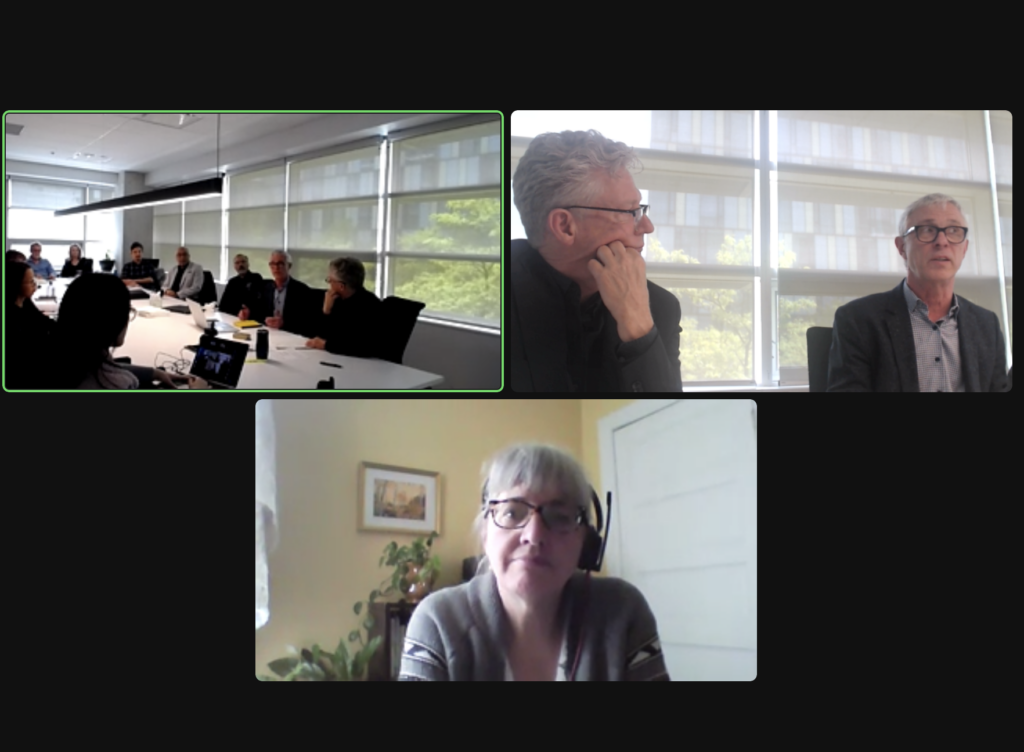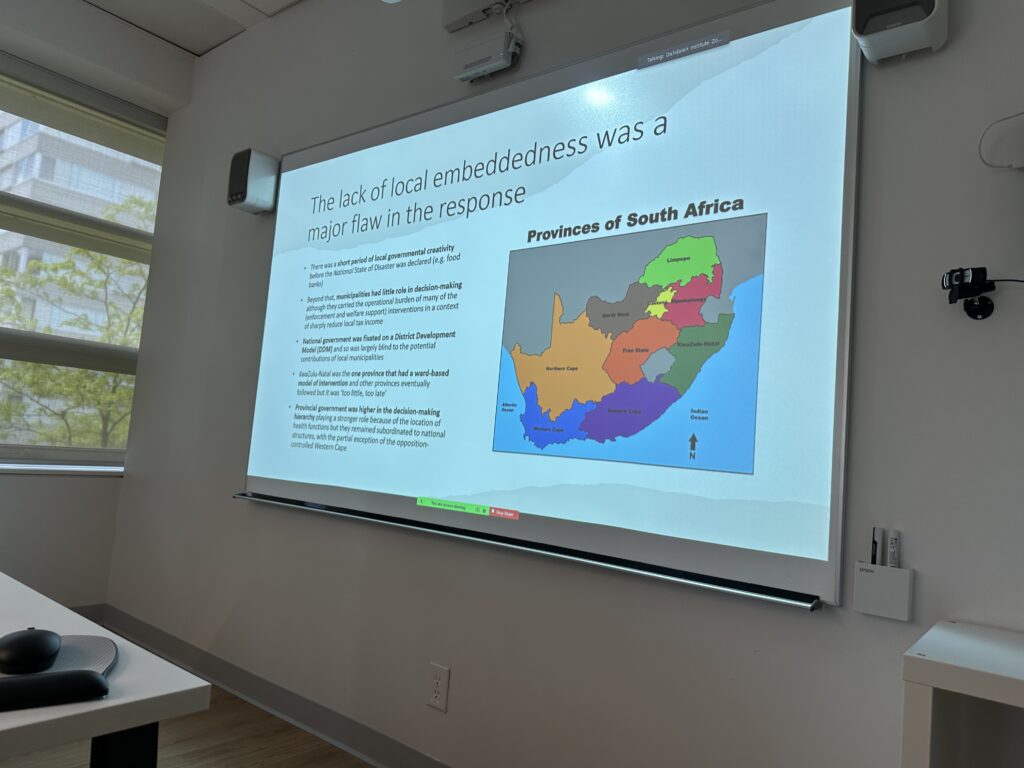Post
Published on June 12, 2023
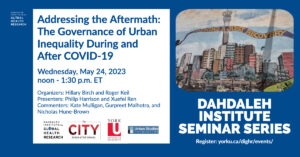
In this seminar on May 24, Dahdaleh graduate student scholar Hillary Birch and Dahdaleh faculty fellow Roger Keil along with their colleagues shared their findings on how communities and governments in Johannesburg, Chicago, and Toronto were affected by and responded to the COVID-19 pandemic. The presentation was titled “Addressing the Aftermath: The Governance of Urban Inequality During and After COVID-19.”
This work was funded by an Urban Studies Foundation Pandemics and Cities grant. The project focuses on the social, spatial, and institutional issues exacerbated by the pandemic in these three cities as well as the policies and programs implemented by local governments and community organizations to mitigate the effects of the pandemic. The research team wil produce a comparative analysis across the three cities.
Professor Keil opened the panel presentation with a brief introduction to the project. He highlighted how the pandemic forced researchers to ask what body of knowledge we could have had before COVID-19 started, as this pandemic is only one of many outbreaks cities around the world have had to contend with. He went on to stress that as we move on from the emergency phase of the response to the virus, we need to consider what we need to know now before we face another pandemic. A comparative study, like that which his team is undertaking, is essential in advancing this body of knowledge.
In the first case study, Professor Phil Harrison (University of Witwatersrand) highlighted efforts that the South African government and civil society made to mobilize aid for communities and to organize a response to the pandemic. Over the course of the pandemic collaboration across civil society and the government was limited and a local-level response to the virus in Johannesburg did not clearly manifest, instead remaining fairly hierarchical and non-differentiated spatially. Local government action was further constrained by serious limitations in access to data and information about the virus’ spread in the city as the pandemic unfolded. Despite one of the world’s toughest lockdowns and previous experience responding to HIV/AIDS, South Africa saw a high number of excess deaths and a 51% decrease in the nation’s GDP during the first quarter of 2020 as a consequence of the pandemic and the state’s response the virus. Professor Harrison closed by suggesting the pandemic was revealing of state capacity in Johannesburg and the wider Gauteng metropolitan area, bringing to light existing strengths as well as prior pathologies.
In the second case study, Professor Xuefei Ren (Michigan State University) presented how Chicago remains a segregated city, where the ‘neighbourhood effect’ determines local residents’ opportunities and life expectancy. For example, prior to the COVID-19 pandemic, White Chicagoans had a life expectancy of 80.2 years and Black Chicagoans had a life expectancy of 71.4 years. During the pandemic, Black Chicagoans life expectancy dropped further by two years while White Chicagoans dropped by less than one. Professor Ren elaborated on Chicago’s hyper-local approach in creating programs to respond to the impact of the pandemic. She presented the Racial Equity Rapid Response Team, Protect Chicago Plus, and Healthy Chicago Equity Zones, all of which aimed to provide financial aid, resources, services, and vaccinations to lower-income neighbourhoods occupied by majority Black and Latino residents. In collaborating with local community organizations, the Chicago government saw varying degrees of success, but critics believe these efforts came too little, too late, starting only when social inequalities became more prominent.
In the last case study, Hillary Birch provided an overview of the civil society and government response to the COVID-19 pandemic in Toronto. The spread of the virus in the Greater Toronto Area (GTA) revealed existing spatial relations that cross administrative boundaries. For example, in wealthier areas close to Toronto’s center, more people worked from home, and, by consequence, there were lower rates of infection in these areas. These communities were also the first to get access to, and have significant uptake of, vaccines when they became available. In comparison, those who lived in lower-income areas in the periphery of Toronto and in the GTA were less likely to stay home to work and infection rates were higher in these postal codes. During the early vaccine roll-out access to, and uptake of, vaccines was much slower in these areas, speaking to existing inequalities in access to health services in the city. In terms of state capacity and the role of civil society, the Toronto city government invited over 400 civil society organizations to collaborate on a hyperlocal approach through a ‘cluster table model’ that served to coordinate activities between state and society in the city. While robust in terms of participation, observers noted that this strategy tended to focus on service delivery efforts and had been a missed opportunity for promoting and supporting community resilience.
Finally, the invited discussants commented on the presentations and provided perspectives from their own work during the pandemic. Gurpreet S. Malhotra (CEO, Indus Community Services) spoke about his experience in the Peel region of the GTA, where many areas have been persistently underfunded and underserved. Peel was greatly impacted by the pandemic in part because of the high portion of multi-generational families in a single household, meaning the virus easily spread between family members. However, this family structure also meant that sick loved ones were more closely monitored and cared for, in contrast to seniors who lived in long-term care homes. Gurpreet also stated that the pandemic, coupled with the Black Lives Matter protests, opened a conversation about race and health inequality in Toronto which was previously avoided, stressing that this should remain a priority even after the declaration of the end of the pandemic. Next, Nicholas Hune-Brown (Senior Editor, The Local), discussed the work of his publication in data mapping and reporting on the social determinants of health, determinants which shaped the outcomes of the pandemic in Toronto. Nicholas also spoke of how having access to data during the pandemic did not necessarily equate to political or policy change and how it is not entirely clear what will happen in the ‘post-pandemic’ era after these inequities have been revealed in the city. As the Toronto mayoral by-elections are quickly approaching (June 2023), it is a critical time to see how attention to health inequity will last beyond the emergency phase of the pandemic in the city.
Watch the seminar presentation below:
Connect with Hillary Birch and Roger Keil
Themes | Global Health & Humanitarianism |
Status | Active |
Related Work |
N/A
|
Updates |
N/A
|
People |
Roger Keil, Faculty Fellow, Faculty of Environmental and Urban Change - Active
Hillary Birch, Dahdaleh Global Health Graduate Scholar, Faculty of Environmental and Urban Change - Active |
You may also be interested in…
Announcing the Winners of the 2024 Seed Grants in Critical Social Science Perspectives in Global Health Research
Following the fifth annual Critical Perspective for Global Health Research (CPGH) workshop in April, the CPGH Steering Committee is delighted to announce that the following York researchers have been awarded this year’s $7,000 seed grants …Read more about this Post
Internship Program: Summer 2024 in Review
This summer, the Dahdaleh Institute has worked with wonderful students through our dynamic, experiential education Global Health Internship Program. The program offers students the ability to contribute to exciting research projects by working on literature reviews, …Read more about this Post
Recap — Mindfulness Meditation at the Dahdaleh Institute
On March 1, the Dahdaleh Institute welcomed Susan Harris to lead members of the community in a Mindfulness Meditation session, the second instalment to a three-part Wellness & Self-Care mini-series. After a half-hour long guided …Read more about this Post

